Ingersoll Rand TZE3500, TZE400 User Manual

!
This dryer configuration includes equipment options as selected (X) below:

 EMS OPTION
EMS OPTION

 LDP OPTION
LDP OPTION

 3V OPTION
3V OPTION
More Than Air. Answers.
Online answers: http://www.air.irco.com
Phone : 1-800-526-3615
Form: APDD 792
CCN: 38019683
Z103146 Rev. 10

USER MANUAL
TZE400 to TZE3500 with EMS
REV 10 – 23 February 2006
FOREWORD
Reading this user manual will fully familiarize you with the Ingersoll-Rand adsorption dryer. You will be better able to run this equipment in accordance with its intended use.
This manual contains important information for safe, proper and economic dryer installation, start-up, operation and maintenance. Always keep it within reach where the adsorption dryer is being used.
It is necessary to follow all instructions as written. Careful reading will avert danger, avoid unnecessary downtime, and minimize work for yourself and wear on the equipment.
In addition to carefully reading this technical manual in its entirety, you must understand your National, State and local rules and regulations regarding safety in the workplace, their necessary precautions and procedures.
Each person responsible for the set-up, start-up, operation, maintenance or repair of this adsorption dryer must have first read and understood this user manual – including all the safety tips.
NOTE: Ingersoll-Rand recommends that installation, start-up and maintenance be carried out by its factory-trained technicians in a regularly scheduled, site-dedicated program. This will ensure the safety of personnel, the integrity of equipment and the surety of warranty coverage.
i

USER MANUAL TZE400 to TZE3500 with EMS REV 10 – 23 February 2006
ii

|
|
|
USER MANUAL |
|
|
TZE400 to TZE3500 with EMS |
|
|
|
|
REV 10 – 23 February 2006 |
|
|
TABLE OF CONTENTS |
|
1. INTRODUCTION .................................................................................................................................................. |
1 |
||
1.1 |
GENERAL............................................................................................................................................................. |
1 |
|
1.2 |
PRODUCT INFORMATION...................................................................................................................................... |
1 |
|
1.2.1 |
Pressure Vessel Regulations........................................................................................................................ |
2 |
|
1.2.2 |
Leak Test...................................................................................................................................................... |
2 |
|
1.3 |
SAFETY INSTRUCTIONS........................................................................................................................................ |
2 |
|
1.3.1 |
Identification of Signs and Symbols in this Manual..................................................................................... |
2 |
|
1.3.2 |
General Safety Tips for Assembly, Inspection and Maintenance................................................................. |
3 |
|
1.4 |
TECHNICAL DATA SHEET .................................................................................................................................... |
4 |
|
1.4.1 Models TZE400 to TZE820.......................................................................................................................... |
4 |
||
1.4.2 Models TZE1000 to TZE1800...................................................................................................................... |
5 |
||
1.4.3 Models TZE2100 to TZE3500...................................................................................................................... |
6 |
||
1.4.4 |
Dryer Flow Capacities ................................................................................................................................ |
7 |
|
1.5 |
OVERLOADING .................................................................................................................................................... |
8 |
|
1.6 |
TRANSPORT ......................................................................................................................................................... |
8 |
|
1.7 |
STORAGE ............................................................................................................................................................. |
8 |
|
1.8 |
USE OF A PREFILTER AND AFTERFILTER .............................................................................................................. |
8 |
|
2. INSTALLATION.................................................................................................................................................... |
9 |
||
2.1 |
GENERAL............................................................................................................................................................. |
9 |
|
2.2 |
MECHANICAL ASSEMBLY .................................................................................................................................... |
9 |
|
2.3 |
FILTER INSTALLATION....................................................................................................................................... |
10 |
|
2.3.1 |
Prefilter Installation (Shipped Loose) ....................................................................................................... |
10 |
|
2.3.2 |
Afterfilter Installation (Shipped Loose) ..................................................................................................... |
11 |
|
2.3.3 |
Filter Skid with 3 Valve Bypass (If Dryer Includes 3V Option)................................................................. |
11 |
|
2.4 |
ELECTRICAL CONNECTION ................................................................................................................................ |
11 |
|
2.5 |
EMS CONTROL CONNECTION ........................................................................................................................... |
12 |
|
3. EQUIPMENT OPERATION .............................................................................................................................. |
13 |
||
3.1 |
GENERAL OPERATING PRINCIPLES .................................................................................................................... |
13 |
|
3.1.1 Dryer Program Steps................................................................................................................................. |
14 |
||
3.2 |
OPERATOR CONTROLS / LOW-VOLTAGE CONTROL PANEL ............................................................................... |
16 |
|
3.2.1 |
Dryer Status............................................................................................................................................... |
18 |
|
3.2.2 |
Alarm Information ..................................................................................................................................... |
19 |
|
3.2.3 Dryer Operation Modes............................................................................................................................. |
20 |
||
3.2.4 |
Heater Sheath Information ........................................................................................................................ |
20 |
|
3.2.5 |
Heater Outlet Information ......................................................................................................................... |
21 |
|
3.2.6 |
Regeneration Outlet Information............................................................................................................... |
21 |
|
3.2.7 Dryer Off, Dryer On, EMS On – 3-Position Switch.................................................................................. |
21 |
||
3.2.8 |
Status Lamps.............................................................................................................................................. |
22 |
|
3.2.9 Pressure Gages.......................................................................................................................................... |
22 |
||
3.3 |
INITIAL START-UP ............................................................................................................................................. |
22 |
|
3.3.1 |
Pressurizing Dryer..................................................................................................................................... |
22 |
|
3.3.2 |
Energizing Dryer Controls ........................................................................................................................ |
23 |
|
3.3.3 |
Pressure Switch Adjustment....................................................................................................................... |
24 |
|
3.3.4 EMS Start Up............................................................................................................................................. |
24 |
||
3.4 |
SHORT-TERM SHUTDOWN................................................................................................................................. |
26 |
|
3.5 |
SHUTDOWN IN CASE OF A FAULT OR FOR MAINTENANCE ................................................................................. |
26 |
|
3.6 |
RESTARTING...................................................................................................................................................... |
26 |
|
4. MAINTENANCE.................................................................................................................................................. |
27 |
||
4.1 |
CHECKLIST ........................................................................................................................................................ |
27 |
|
iii

|
|
USER MANUAL |
|
|
TZE400 to TZE3500 with EMS |
|
|
REV 10 – 23 February 2006 |
4.1.1 Daily Check ............................................................................................................................................... |
27 |
|
4.1.2 Weekly Check.............................................................................................................................................. |
27 |
|
4.1.3 Quarterly Check (Every Three Months) .................................................................................................... |
27 |
|
4.1.4 Annual Check............................................................................................................................................. |
28 |
|
4.2 |
CHANGING THE FILTER ELEMENT...................................................................................................................... |
28 |
4.3 |
REPLACEMENT OF THE DESICCANT ................................................................................................................... |
29 |
5. PARTS LISTINGS ............................................................................................................................................... |
31 |
|
5.1 |
PARTS LIST FOR TZE400 TO TZE650................................................................................................................ |
31 |
5.2 |
PARTS LIST FOR TZE820 TO TZE1225.............................................................................................................. |
32 |
5.3 |
PARTS LIST FOR TZE1500 TO TZE2100............................................................................................................ |
33 |
5.4 PARTS LIST FOR TZE2500 TO TZE3500............................................................................................................. |
34 |
|
6. FAULTS AND TROUBLESHOOTING............................................................................................................. |
38 |
|
6.1 |
DEWPOINT HAS DETERIORATED ............................................................................................................. |
38 |
6.2 |
HIGH HUMIDITY ALARM OR SENSOR FAILURE ................................................................................... |
39 |
6.3 |
PRESSURE DROP TOO HIGH....................................................................................................................... |
39 |
6.4 |
SWITCHING FAILURE ALARM................................................................................................................... |
39 |
7. DRAWINGS.......................................................................................................................................................... |
42 |
|
iv

USER MANUAL
TZE400 to TZE3500 with EMS
REV 10 – 23 February 2006
1. INTRODUCTION
1.1 GENERAL
This adsorption dryer includes the latest technology and safety features. Its use, however, can endanger life and limb and can lead to considerable damage to the equipment and other material assets if:
∙it is operated by personnel not instructed in its use,
∙it is improperly used,
∙it is improperly maintained or serviced.
Furthermore, ignorance of its use and proper service can result in the loss of any claim for damage.
This adsorption dryer is designed for neutral media (such as air or nitrogen) which is free of aggressive water, oil and solid elements. Ingersoll-Rand accepts no liability for corrosion damage or malfunctions caused by aggressive media.
Applications other than those mentioned in this manual must be agreed to by IngersollRand and confirmed in writing.
Ingersoll-Rand reserves the right to make changes at any time as may be necessary for increasing safety or efficiency, or In the interests of further product development.
1.2 PRODUCT INFORMATION
The adsorption dryer is used for the purpose of drying compressed air and other gases according to its contracted design. Depending on certain conditions at the inlet, it provides pure, dry and oil-free compressed air or gases. The standard model of adsorption dryer is equipped with two desiccant vessels and a prefilter and afterfilter.
This specific model of dryer includes an Energy Management System (EMS) that provides automatic monitoring and control of the work/regeneration cycle to optimize equipment efficiency. This manual includes references to optionally available Low Dew Point (LDP) and 3-valve bypass (3V) systems/assemblies which may or may not be provided. Selected options included with this dryer are indicated on the cover page by an “X” mark in the box.
1
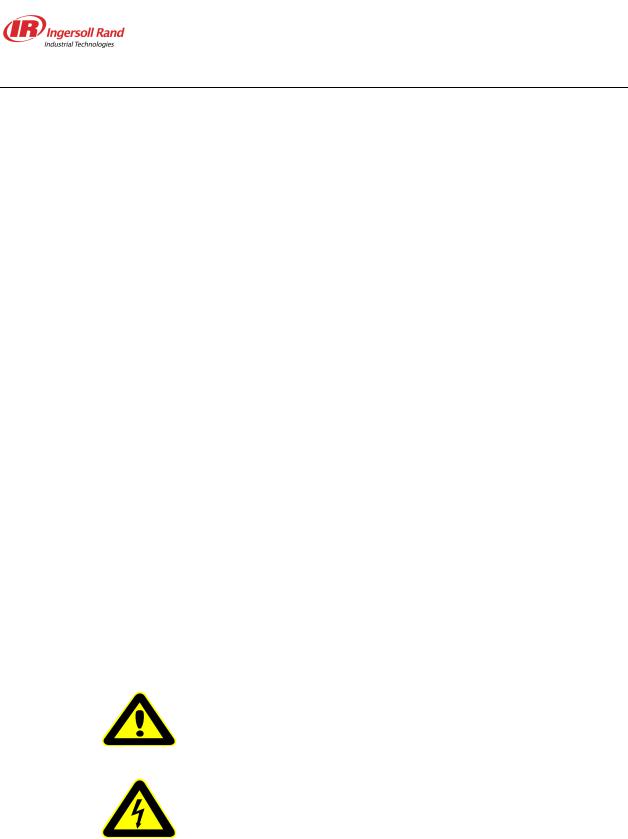
USER MANUAL
TZE400 to TZE3500 with EMS
REV 10 – 23 February 2006
1.2.1 PRESSURE VESSEL REGULATIONS
The pressure vessels are designed and built to meet the American Society of Mechanical Engineers (ASME) standards. They fulfill the test of the certifying procedure and carry the ASME symbols U or UM.
RANGE OF APPLICATION
Design Pressure |
Max: 150 psig |
|
|
|
|
Design Temperature |
Max: 500 °F (260 °C) |
|
Min: -20 °F (-29 °C) |
||
|
1.2.2 LEAK TEST
Each Ingersoll-Rand adsorption dryer is subjected to, and passes, a leak test prior to shipment.
1.3 SAFETY INSTRUCTIONS
This manual contains basic tips which must be followed during set-up, operation and servicing. It is of utmost importance that it be read by the assembly technician before installation and start-up as well as by the specialist/operator in charge. It must always be within reach at the place where the adsorption dryer is being used.
1.3.1 IDENTIFICATION OF SIGNS AND SYMBOLS IN THIS MANUAL
The safety tips contained in this manual, whose disregard could endanger people and equipment, are indicated by a general danger sign and the additional markings Danger! or Attention! or Warning!
Danger! / Attention!
Safety sign in accordance with DIN 4844 - W9
Warning – high voltage!
Safety sign in accordance with DIN 4844 - W8
Safety tips printed directly on the adsorption dryer must be heeded at all times and must be kept completely legible.
2
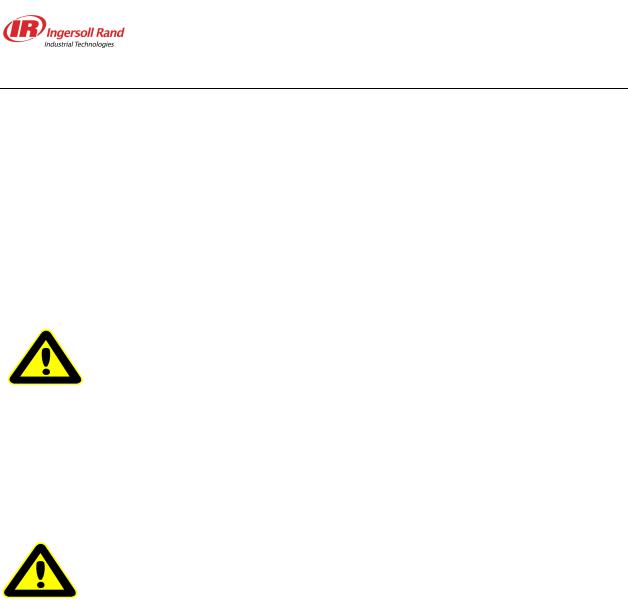
USER MANUAL
TZE400 to TZE3500 with EMS
REV 10 – 23 February 2006
1.3.2 GENERAL SAFETY TIPS FOR ASSEMBLY, INSPECTION AND MAINTENANCE
The purchaser is to ensure that all assembly, maintenance and inspection work is carried out by personnel qualified to do it.
The personnel involved in assembly, operation, maintenance and inspection must have the corresponding qualifications to do this work. Areas of responsibility and supervision of the personnel must be clearly established by the purchaser. Should the personnel not possess the necessary knowledge, then they must be instructed. If need be, this training may be carried out by the manufacturer/supplier at the request of the purchaser. Further, the purchaser is to ensure that all personnel completely understand and follow the content of this manual.
Attention!
∙Never make structural changes to the adsorption dryer
∙Only use recommended spare parts as listed in section 5
∙Never weld on a pressure vessel or change it in any way
∙Carry out maintenance only when the adsorption dryer is OFF, depressurized and disconnected from the electric power supply.
Danger!
∙Review the Material Safety Data Sheet (MSDS) provided with the desiccant
∙Wear protective clothing and goggles when working with the desiccant
∙If desiccant comes into contact with the eyes, rinse eyes immediately with a lot of clear water
∙If the desiccant is spilled, clean up without causing swirls of dust
∙In case of fire, there is no restriction on the use of fire extinguishing material; the reaction with water and foam is defined as strong
∙A mask must be worn whenever handling desiccant.
3
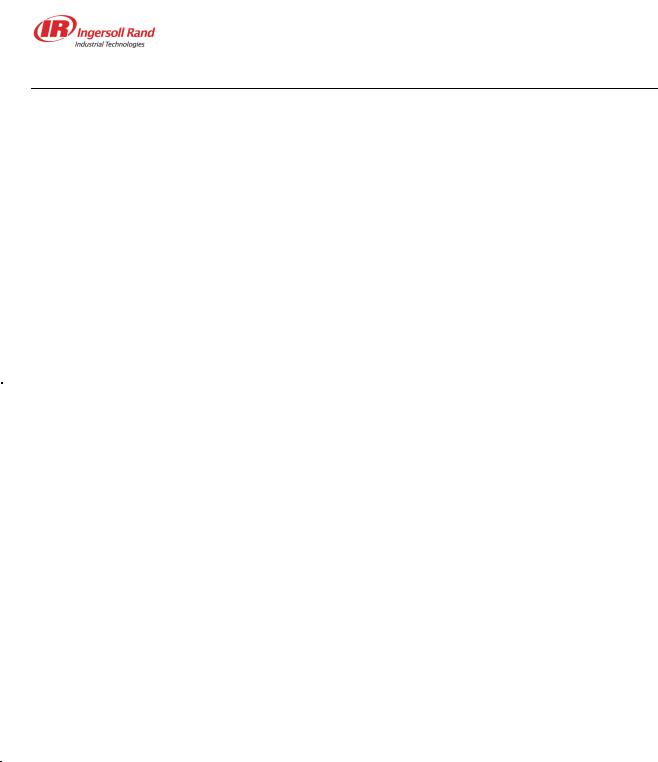
USER MANUAL
TZE400 to TZE3500 with EMS
REV 10 – 23 February 2006
1.4 TECHNICAL DATA SHEET
1.4.1 MODELS TZE400 TO TZE820
Model |
TZE400 |
TZE500 |
TZE650 |
TZE820 |
|
Rated flow @ 100 psig & |
400 scfm |
500 scfm |
650 scfm |
820 scfm |
|
100°F inlet conditions |
|||||
|
|
|
|
||
Chamber Outer Diameter |
18 inches |
18 inches |
18 inches |
20 inches |
|
|
|
Standard (no |
LDP option): |
|
|
Desiccant Bed |
|
100% Activated Alumina |
|
||
272 |
350 |
433 |
660 |
||
Composition & Pounds |
|
With LDP option – Layered: |
|
||
per Chamber |
33% Mol Sieve (bottom), 67% Activated Alumina (top). |
||||
|
1st MS: 90 |
1st MS: 115 |
1st MS: 143 |
1st MS: 218 |
|
|
2nd AA: 182 |
2nd AA: 235 |
2nd AA: 290 |
2nd AA: 442 |
|
Inlet Connection |
2-in NPT |
2-in NPT |
2-in NPT |
3-in RF FLG |
|
Outlet Connection |
2-in NPT |
2-in NPT |
2-in NPT |
3-in RF FLG |
|
Recommended Prefilter |
HE563 |
HE563 |
HE 706 |
HE 1100 |
|
Recommended Afterfilter |
DP563 |
DP563 |
DP 706 |
DP 1100 |
|
Pilot Air Filter |
AR-0003G/B |
AR-0003G/B |
AR-0003G/B |
IR-DP19 |
|
Standard Electric Rqmt |
|
460 Vac/3- |
phase/60 Hz |
|
|
Heater |
6 kW |
6 kW |
8 kW |
12 kW |
|
Cycle Time |
|
8-Hour |
Cycle – |
|
|
4 Hours Drying / 4 Hours Regeneration |
|||||
|
|||||
Outlet Pressure Dewpoint |
|
-40°F PDP (-100°F LDP) |
|
||
EMS Control Setting |
|
-40°F PDP (-100°F LDP) |
|
||
High Humidity Alarm |
|
-35°F PDP (-95°F LDP) |
|
||
Pressure Switch Setpoints |
PSL – 10 psig / PSH – 30 psig below line pressure |
||||
Purge Pressure Setting |
70 psig |
65 psig |
55 psig |
55 psig |
|
Low Purge Alarm Setpoint |
60 psig |
55 psig |
45 psig |
45 psig |
|
Heater Outlet Setpoint |
|
425°F |
|
||
End Heating Temperature |
|
180°F |
|
||
End Cooling Temperature |
|
120°F |
|
||
Heater Sheath Alarm |
|
1000°F |
|
||
Flow Directions |
Downward Drying – Upward Regeneration |
||||
4

USER MANUAL
TZE400 to TZE3500 with EMS
REV 10 – 23 February 2006
1.4.2 MODELS TZE1000 TO TZE1800
Model |
TZE1000 |
TZE1225 |
TZE1500 |
TZE1800 |
|
Rated flow @ 100 psig & |
1000 scfm |
1225 scfm |
1500 scfm |
1800 scfm |
|
100°F inlet conditions |
|||||
|
|
|
|
||
Chamber Outer Diameter |
24 inches |
24 inches |
28 inches |
28 inches |
|
|
|
Standard (no |
LDP option): |
|
|
Desiccant Bed |
|
100% Activated Alumina |
|
||
825 |
990 |
1055 |
1320 |
||
Composition & Pounds per |
|
With LDP option – Layered: |
|
||
Chamber |
33% Mol Sieve (bottom), 67% Activated Alumina (top). |
||||
|
1st MS: 272 |
1st MS: 327 |
1st MS: 348 |
1st MS: 436 |
|
|
2nd AA: 553 |
2nd AA: 663 |
2nd AA: 707 |
2nd AA: 884 |
|
Inlet Connection |
3 in RF FLG |
3 in RF FLG |
3 in RF FLG |
4 in RF FLG |
|
Outlet Connection |
3 in RF FLG |
3 in RF FLG |
3 in RF FLG |
4 in RF FLG |
|
Recommended Prefilter |
HE1100 |
HE 1380 |
HE 2100 |
HE 2100 |
|
Recommended Afterfilter |
DP1100 |
DP 1380 |
DP 2100 |
DP 2100 |
|
Pilot Air Filter |
IR-DP19 |
IR-DP19 |
IR-DP19 |
IR-DP19 |
|
Standard Electric Rqmt |
|
460 Vac/3- |
phase/60 Hz |
|
|
Heater |
17 kW |
21 kW |
25 kW |
28 kW |
|
Cycle Time |
|
8 Hour |
Cycle – |
|
|
4 Hours Drying / 4 Hours Regeneration |
|||||
|
|||||
Outlet Pressure Dewpoint |
|
-40°F PDP (-100°F LDP) |
|
||
EMS Control Setting |
|
-40°F PDP (-100°F LDP) |
|
||
High Humidity Alarm |
|
-35°F PDP (-95°F LDP) |
|
||
Pressure Switch Setpoints |
PSL – 10 PSIG / PSH – 30 PSIG below line pressure |
||||
Purge Pressure Setting |
70 psig |
60 psig |
65 psig |
70 psig |
|
Low Purge Alarm Setpoint |
60 psig |
50 psig |
55 psig |
60 psig |
|
Heater Outlet Set Point |
|
425°F |
|
||
End Heating Temperature |
|
180°F |
|
||
End Cooling Temperature |
|
120°F |
|
||
Heater Sheath Alarm |
|
1000°F |
|
||
Flow Directions |
Downward Drying - Upward Regeneration |
||||
5
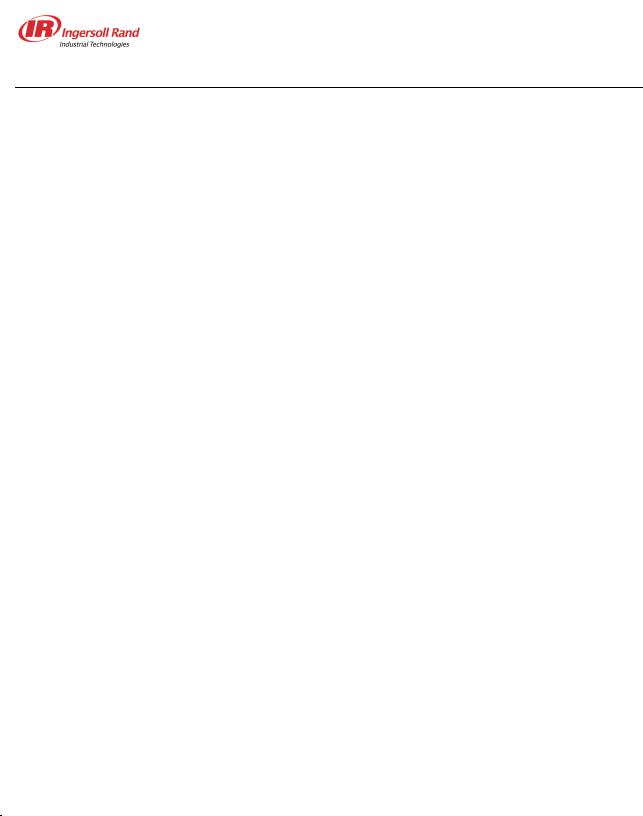
USER MANUAL
TZE400 to TZE3500 with EMS
REV 10 – 23 February 2006
1.4.3 MODELS TZE2100 TO TZE3500
Model |
TZE2100 |
TZE2500 |
|
|
TZE3000 |
|
TZE3500 |
||
Rated flow @ 100 psig & |
2100 scfm |
2500 scfm |
|
|
3000 scfm |
|
3500 scfm |
||
100°F inlet conditions |
|
|
|
||||||
|
|
|
|
|
|
|
|
||
Chamber Outer Diameter |
30 inches |
36 inches |
|
|
40 inches |
|
40 inches |
||
|
|
Standard (no |
LDP option): |
|
|||||
Desiccant Bed |
|
100% Activated Alumina |
|
||||||
1485 |
1722 |
|
2310 |
|
|
2805 |
|||
Composition & Pounds |
|
With LDP option – Layered: |
|
||||||
per Chamber |
33% Mol Sieve (bottom), 67% Activated Alumina (top). |
||||||||
|
1st MS: 490 |
1st MS: 568 |
|
|
1st MS: 762 |
|
1st MS: 926 |
||
|
2nd AA: 995 |
2nd AA: 1154 |
|
|
2nd AA: 1548 |
|
2nd AA: 1879 |
||
Inlet Connection |
4-in RF FLG |
4-in RF FLG |
|
|
6-in RF FLG |
|
|
6-in RF FLG |
|
Outlet Connection |
4-in RF FLG |
4-in RF FLG |
|
|
6-in RF FLG |
|
|
6-in RF FLG |
|
Recommended Prefilter |
HE 2100 |
HE 2750 |
|
|
HE 4100 |
|
|
HE 4100 |
|
Recommended Afterfilter |
DP 2100 |
DP 2750 |
|
|
DP 4100 |
|
DP 4100 |
||
Pilot Air Filter |
IR-DP19 |
IR-DP19 |
|
|
IR-DP19 |
|
IR-DP19 |
||
Standard Voltage |
|
460 Vac/3- |
phase/60 Hz |
|
|||||
Heater |
30 kW |
36 kW |
|
|
43 kW |
|
50 kW |
||
Cycle Time |
|
8-Hour |
Cycle – |
|
|
||||
4 Hours Drying / 4 Hours Regeneration |
|||||||||
|
|||||||||
Outlet Pressure |
|
-40°F PDP (-100°F LDP) |
|
||||||
Dewpoint |
|
|
|||||||
|
|
|
|
|
|
|
|
||
EMS Control Setting |
|
-40°F PDP (-100°F LDP) |
|
||||||
High Humidity Alarm |
|
-35°F PDP (-95°F LDP) |
|
||||||
Pressure Switch Set |
PSL – 10 psig / PSH – 30 PSIG below line pressure |
||||||||
Points |
|||||||||
|
|
|
|
|
|
|
|
||
Purge Pressure Setting |
60 psig |
70 psig |
|
|
65 psig |
|
60 psig |
||
Low Purge Alarm Set |
50 psig |
60 psig |
|
|
55 psig |
|
|
50 psig |
|
Point |
|
|
|
||||||
|
|
|
|
|
|
|
|
||
Heater Outlet Set Point |
|
|
425°F |
|
|||||
End Heating |
|
|
180°F |
|
|||||
Temperature |
|
|
|
||||||
|
|
|
|
|
|
|
|
||
End Cooling |
|
|
120°F |
|
|||||
Temperature |
|
|
|
||||||
|
|
|
|
|
|
|
|
||
Heater Sheath Alarm |
|
1000°F |
|
||||||
Flow Directions |
Downward Drying - Upward Regeneration |
||||||||
6
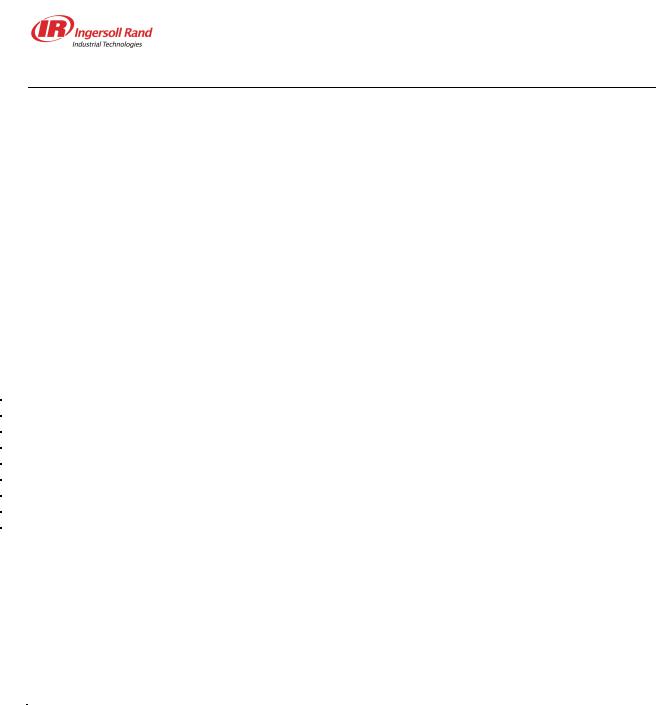
USER MANUAL
TZE400 to TZE3500 with EMS
REV 10 – 23 February 2006
1.4.4 DRYER FLOW CAPACITIES
The specific size/model of your dryer was selected to meet performance requirements based on an analysis of air supply and demand capacities. The model selection chart provided following should confirm that this dryer remains suitable for its intended use.
The table following is based on -40oF PDP, 8-hour cycle, activated alumina and average inlet air flow for non-LDP-equipped dryers with EMS. Consult our factory for rated air flows on LDP-equipped dryers.
|
Design Inlet |
|
|
Rated inlet air flow (scfm) at given pressures (psig) |
|
|
||||||
MODEL |
|
|
|
(Based upon 100oF inlet air temperature) |
|
|
||||||
Air Pressure |
|
|
|
|
|
|
|
|
|
|
|
|
|
|
|
|
|
|
|
|
|
|
|
||
|
(psig) |
60 |
70 |
|
80 |
90 |
100 |
110 |
120 |
|
130 |
140 |
|
|
|
|
|
|
|
|
|
|
|
|
|
TZE400 |
150 |
220 |
265 |
|
310 |
355 |
400 |
440 |
480 |
|
520 |
550 |
TZE500 |
150 |
305 |
355 |
|
400 |
460 |
500 |
550 |
590 |
|
645 |
680 |
TZE650 |
150 |
360 |
435 |
|
505 |
580 |
650 |
705 |
790 |
|
850 |
905 |
TZE820 |
150 |
460 |
550 |
|
640 |
735 |
820 |
905 |
990 |
|
1070 |
1150 |
TZE1000 |
150 |
615 |
715 |
|
805 |
920 |
1000 |
1140 |
1255 |
|
1325 |
1420 |
TZE1225 |
150 |
690 |
825 |
|
955 |
1100 |
1225 |
1360 |
1490 |
|
1610 |
1735 |
TZE1500 |
150 |
785 |
960 |
|
1150 |
1275 |
1500 |
1600 |
1730 |
|
1875 |
2010 |
TZE1800 |
150 |
1010 |
1210 |
|
1405 |
1610 |
1800 |
1995 |
2190 |
|
2375 |
2535 |
TZE2100 |
150 |
1095 |
1345 |
|
1600 |
1835 |
2100 |
2275 |
2500 |
|
2700 |
2890 |
TZE2500 |
150 |
1480 |
1735 |
|
1985 |
2270 |
2500 |
2820 |
3100 |
|
3355 |
3585 |
TZE3000 |
150 |
1685 |
2015 |
|
2340 |
2680 |
3000 |
3330 |
3645 |
|
3960 |
4235 |
TZE3500 |
150 |
1900 |
2300 |
|
2700 |
3095 |
3500 |
3845 |
4195 |
|
4570 |
4890 |
Higher pressures are optionally available. Consult factory.
To correct for an inlet temperature other than 100oF, multiply dryer capacity by the temperature correction factor listed below.
CORRECTION FACTOR FOR INLET TEMPERATURE
TEMPERATURE |
80 |
90 |
100 |
105 |
110 |
115 |
120 |
|
DEGREES F |
||||||||
|
|
|
|
|
|
|
||
Correction Factor |
1.1 |
1.1 |
1.0 |
0.85 |
0.69 |
0.565 |
0.455 |
Example: To size for an inlet flow of 950 SCFM @ 105 F and 110 psig.
1.Select model that produce at least 950 SCFM at 110 psig. This case would be the TZE1000 which can dry 1140 SCFM.
2.Multiply pressure corrected flow by the temperature correction factor to obtain the flow of the dryer corrected for pressure and temperature:
1140 X (0.85) = 969 SCFM
3.Confirm model selection. Model TZE1000 can flow 969 SCFM at the inlet conditions specified; requirements of 950 SCFM are less: TZE1000 is correct.
7
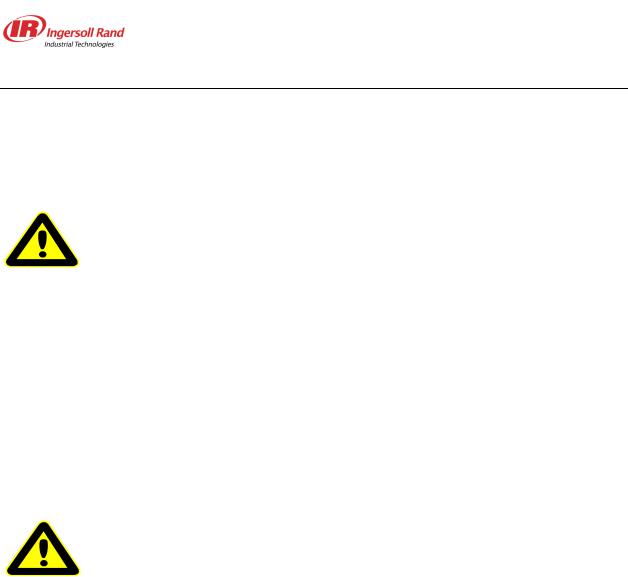
USER MANUAL
TZE400 to TZE3500 with EMS
REV 10 – 23 February 2006
NOTE: Settings for EMS: |
Standard Dryers: |
EMS Control |
-40°F (-40°C) |
|
|
High Humidity -35°F (-35°C) |
|
|
LDP Dryers: |
EMS Control |
-100°F (-74°C) |
|
|
High Humidity -95°F (-69°C). |
|
1.5 OVERLOADING
Attention! Protect the adsorption dryer from overloads!
The adsorption dryer can become overloaded if:
∙The flow volume of the medium to be dried increases
∙The temperature of the air at entry and, correspondingly, its humidity increases
∙The minimum operating pressure decreases
∙The prefiltration and separation of impurities are not sufficient or the filter drain fails
∙Introduction of oil into the air stream.
1.6TRANSPORT
Immediately upon delivery of the adsorption dryer, it must be checked for any damage that may have occurred during transport. If necessary, the damage must be recorded on the shipping waybill/receipt. Liability for such damage usually rests with the shipper. Contact Ingersoll-Rand to arrange for any required service or replacement parts.
Attention!
For transport within your company site, only the skids of the adsorption dryer may be used. Lifting at any other points on the equipment will void the warranty and damage the equipment.
1.7 STORAGE
If the adsorption dryer is to be stored for a long period of time, its place of storage must be dry and free of dust. The ambient temperature cannot go below 33°F (+1°C).
1.8 USE OF A PREFILTER AND AFTERFILTER
In order to prevent droplets of condensate, oil and dirt from getting into the desiccant, a Ingersoll-Rand prefilter must be installed upstream of the adsorption dryer. An oil film on the desiccant reduces the drying capacity and the dewpoint. In order to prevent breakdown in downstream consumers caused by material that has been abraded from the desiccant bed, a Ingersoll-Rand afterfilter must be mounted behind the adsorption dryer. Since no condensate accumulates in the afterfilter, this filter is always equipped with a manual vent valve.
8

USER MANUAL
TZE400 to TZE3500 with EMS
REV 10 – 23 February 2006
Both filters are equipped with a differential pressure indicator to ensure a direct display of the degree of contamination of the filter elements.
2. INSTALLATION
2.1 GENERAL
Ensure that the installation site is free of dust, dirt and litter. The site floor must be level and strong enough to support the equipment. The site itself must be an heated environment (minimum 50°F) to ensure proper operation and warranty protection.
Ensure that the Ingersoll-Rand adsorption dryer is carried only by its skid base frame. The adsorption dryer must be positioned so that the side from which it is to be operated is easily accessible. The piping is to be connected at a slightly downward slope. Install isolation valves on the inlet and outlet sides of the adsorption dryer. Also, a bypass pipe with an additional isolation valve should be mounted onto the adsorption dryer to allow for an uninterrupted supply of compressed air in case the adsorption dryer requires maintenance or repair. The bypass assembly is optionally provided (see paragraph 1.2) or can be customer furnished. If vibrations occur at the installation site, the adsorption dryer skid frame is to be placed onto vibration dampers.
2.2MECHANICAL ASSEMBLY
∙The equipment should be located in an area with adequate clearances for service. An overhead clearance of not less than two feet above each desiccant tower is required for loading of the desiccant.
∙Remove all protective shipping crates, flange covers, etc.
∙Using the mounting holes provided on the skid, anchor the dryer to a solid, level foundation designed to support the equipment.
∙Do not hydrostatically test the pressure vessels. All TZE dryer pressure vessels and welded piping are hydrostatically tested at one and one-half times the design pressure after fabrication and before assembly.
∙Desiccant for models TZE820 and up is shipped loose and must be installed on site. Refer now to paragraph 4.3 for instructions on installing the desiccant.
∙If the equipment is installed in a high traffic area, protective barriers may be required to prevent possible damage of equipment and to prevent contact with hot surfaces.
∙Due to vibration during shipping some tube fittings may have loosened. Therefore, inspect all connections and tighten if required.
9
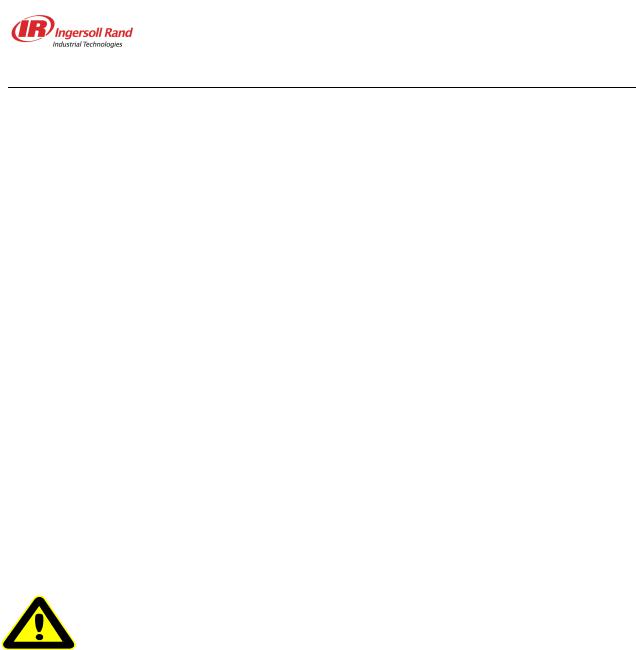
USER MANUAL
TZE400 to TZE3500 with EMS
REV 10 – 23 February 2006
∙Ensure that the inlet and outlet connections to and from the dryer are made using the correctly rated fittings and piping to meet the design conditions.
NOTE: System isolation and by-pass valves should be installed. If not supplied by Ingersoll-Rand as part of the equipment package (i.e., 3V option – see paragraph 1.2), they should be supplied and installed by others. Ensure that this bypass facility is installed so that future servicing of the dryer system off-line may take place.
∙Full flow relief valves to protect the system from over-pressure must be customer-provided in accordance with local regulations.
∙The purge exhaust on the TZE650 and smaller dryers is equipped with an exhaust muffler. If required, the muffler can be removed and purge exhaust can be connected to a vent header. Follow recommendations for pipe sizing listed below.
∙The purge exhaust connection on the TZE820 and larger dryers must be connected to a vent header. To ensure satisfactory regeneration of the desiccant chambers, the purge exhaust piping should be sized as follows to prevent backpressure build up.
EXTENDED LENGTH |
PIPE SIZE REQUIRED |
TO 10 FEET |
SAME SIZE AS DRYER EXHAUST |
TO 25 FEET |
1 SIZE LARGER THAN DRYER EXHAUST |
TO 50 FEET |
2 SIZES LARGER THAN DRYER EXHAUST |
TO 100 FEET |
3 SIZES LARGER THAN DRYER EXHAUST |
Caution!
The noise at the outlet of the exhaust header may exceed 100 dBa, and the flow velocity will be high. Exhaust must be piped to an area where these flow velocities and noise levels can be safely tolerated.
2.3 FILTER INSTALLATION
2.3.1 PREFILTER INSTALLATION (SHIPPED LOOSE)
∙Mount prefilter in such a way as to allow clearance for the element installation and removal.
∙Locate the prefilter as close to the dryer inlet connection as possible.
∙The filter must be piped so that the correct flow direction indicated on the filter is followed.
10
